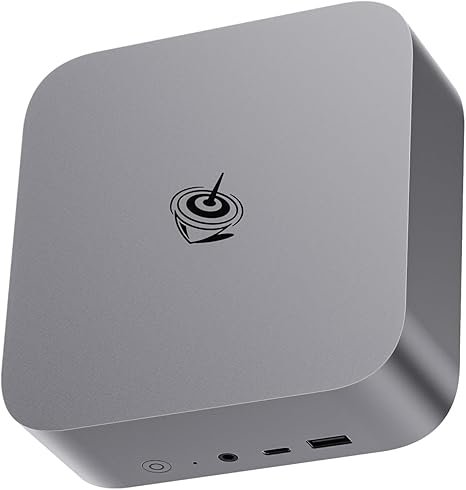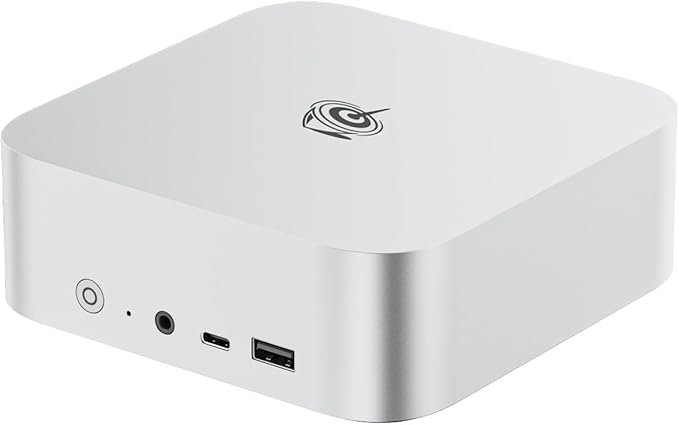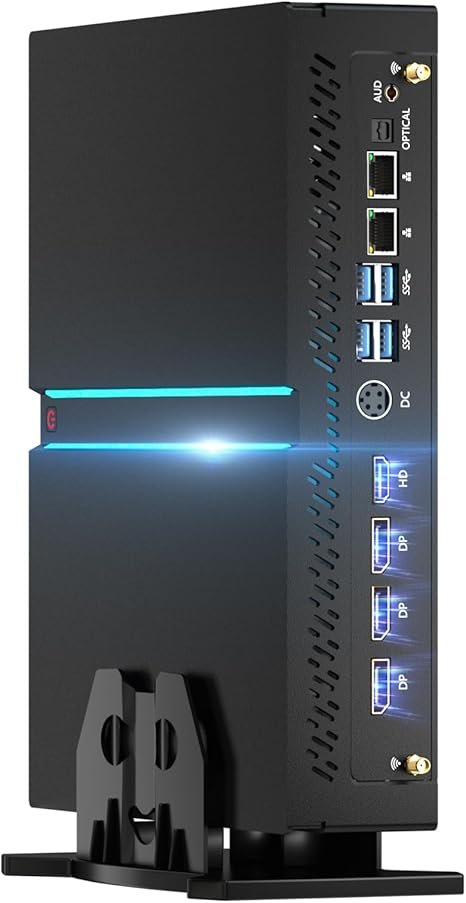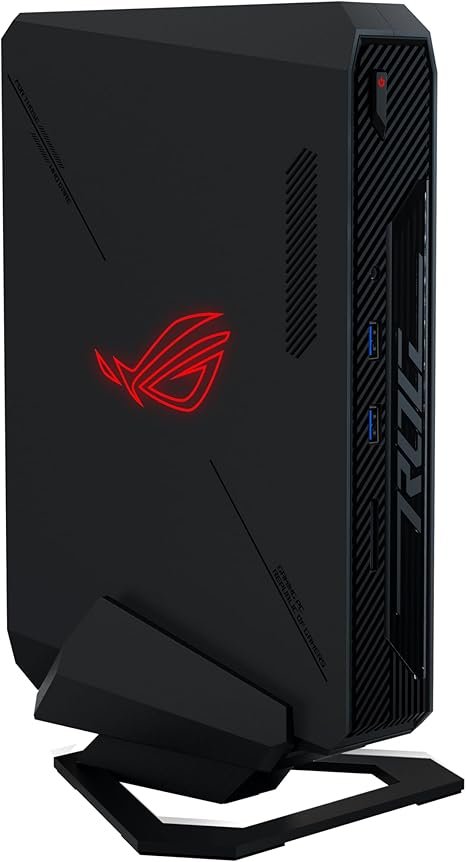Best Mini PCs Over 1000€ in 2025: Elite Performance Picks
Discover our handpicked selection of premium mini PCs over 1000€ for 2025, powered by Intel Core Ultra, AMD Ryzen AI, and NVIDIA RTX graphics. These compact powerhouses are perfect for 4K gaming, professional content creation, virtualization, and replacing your high-end desktop.
Table of Contents
Why Choose a Mini PC Over 1000€ in 2025?
Let’s be honest—when you’re investing over 1000€ in a mini PC, you’re not just buying a computer. You’re getting a compact powerhouse that can rival, and often surpass, traditional desktop towers. These machines pack the latest Intel Core Ultra and AMD Ryzen AI processors, sometimes paired with dedicated GPUs like NVIDIA’s RTX 4070. Whether you’re a hardcore gamer chasing buttery-smooth 4K experiences, a creative professional working with 8K video, or a developer running complex virtual environments, these mini PCs deliver elite performance without the bulk.
What really sets these premium mini PCs apart is their versatility. Imagine editing 8K video while running multiple virtual machines in the background, or playing the latest AAA games at 1440p while streaming to Twitch—all from a device that fits in your palm. Our team at MiniPCDeals.net has spent countless hours testing and comparing these high-end models to bring you only the best options in this premium price range. We’ve looked at everything from raw performance to cooling efficiency to ensure you get a machine that won’t just meet your needs today, but will continue to impress for years to come.
If you’re specifically interested in content creation, you might want to check out our detailed guide to mini PCs for video editing. It’s packed with insights tailored for creators who need that extra edge in their workflow.
What Can a Mini PC Over 1000€ Actually Do?
When you step into the 1000€+ mini PC territory, you’re entering a whole new league of computing power. These aren’t just slightly better versions of budget models—they’re complete game-changers. Let’s break down what makes them so special:
For professionals, these machines are absolute workhorses. We’re talking about handling massive datasets, compiling complex codebases, or running resource-intensive applications—all while maintaining silky-smooth performance. The combination of high-core-count processors (think 12-24 cores) and up to 96GB of DDR5 RAM means you can have dozens of Chrome tabs open alongside your IDE, virtual machines, and creative suites without breaking a sweat. It’s the kind of multitasking power that would make most traditional desktops jealous.
Gamers, this is where things get exciting. With dedicated GPUs like the NVIDIA RTX 4070 or advanced integrated graphics like AMD’s Radeon 890M, you’re looking at genuine 1440p gaming at high settings, and even 4K gaming with some tweaks. We’re not talking about “it runs, but barely”—these mini PCs deliver smooth frame rates in modern AAA titles. And with features like ray tracing and DLSS support, you’re getting a premium gaming experience in a package that fits on your desk without dominating it.
Content creators will find these mini PCs to be dream machines. Real-time 4K video editing? No problem. Complex 3D rendering? Handled with ease. Professional music production with hundreds of tracks and effects? These machines laugh at such challenges. The combination of powerful CPUs, fast NVMe storage, and in some cases dedicated GPUs means you can work with 8K footage, apply complex effects in real-time, and render your projects faster than many traditional workstations. It’s the kind of performance that can genuinely transform your creative workflow.
For developers and IT professionals, the virtualization capabilities are where these mini PCs truly shine. Need to run multiple virtual machines simultaneously? Want to test software across different operating systems without rebooting? These machines handle it all with ease. The combination of high core counts, ample RAM, and in some cases dedicated NPUs (Neural Processing Units) means you can run resource-intensive development environments, Docker containers, and even AI training workloads without slowing down. It’s like having a mini data center on your desk.
Perhaps most impressively, these mini PCs can completely replace a high-end desktop tower for most users. You’re getting equivalent (and in many cases, superior) performance in a package that’s a fraction of the size and uses significantly less power. Whether you’re a gamer, creator, or professional, you’re getting a machine that can handle everything you throw at it while taking up less space than a shoebox. And with their efficient cooling systems, they do it all without sounding like a jet engine.
Connectivity is another area where these premium mini PCs excel. We’re talking Thunderbolt 4 ports for lightning-fast data transfers, USB4 for versatile peripheral connections, Wi-Fi 6E or even Wi-Fi 7 for wireless speeds that rival wired connections, and dual 2.5G LAN ports for rock-solid network performance. Many models also support multiple 4K or even 8K displays, making them perfect for complex workflows that require lots of screen real estate. Some even include OCuLink ports for adding external GPUs, giving you room to grow as your needs evolve.
Top Mini PCs Over 1000€ in 2025
Compare Mini PCs Over 1000€ in 2025
| Model | Processor | RAM | Storage | Best For | Links |
|---|---|---|---|---|---|
| Beelink SEi14 Mini PC | Intel Core Ultra 9 185H | 96GB DDR5 | 2TB PCIe4.0 SSD | Productivity, AI workloads | Amazon |
| Beelink SER9 Mini PC | AMD Ryzen 9 AI HX 370 | 64GB LPDDR5X | 2TB PCIe4.0 SSD | Gaming, creative work | Amazon |
| Kinupute Gaming i9 Mini PC | Intel Core i9-13900F | 64GB DDR5 | 2TB PCIe4.0 SSD | 4K gaming, 3D rendering | Amazon |
| ROG NUC 970 Mini PC | Intel Core Ultra 9 185H | 32GB DDR5 | 1TB PCIe G4x4 SSD | Gaming, premium design | Amazon |

Best for Productivity & AI: Beelink SEi14 Mini PC
The Beelink SEi14 isn’t just a mini PC—it’s a productivity powerhouse that redefines what compact computing can achieve. At its heart beats the Intel Core Ultra 9 185H processor, a 16-core, 22-thread monster that can boost up to 5.1GHz when you need that extra punch. But what really sets this machine apart is the massive 96GB of DDR5 RAM—yes, you read that right. This isn’t just future-proofing; it’s future-domination.
For professionals who live in their workstations, this means you can have your IDE open with multiple projects, a handful of virtual machines running different environments, your email client, communication tools, and still have plenty of headroom for whatever else you need to throw at it. The 2TB PCIe 4.0 SSD ensures that all your applications load in the blink of an eye, and with Thunderbolt 4 connectivity, you’re getting data transfer speeds that will make your old USB 3.0 drives look like they’re from the Stone Age.
What really makes the SEi14 special is its NPU (Neural Processing Unit). This isn’t just marketing fluff—it genuinely accelerates AI workloads, making tasks like machine learning model training, AI-assisted video editing, or even local AI chatbots run significantly faster. The triple display support (HDMI, DisplayPort, and Thunderbolt 4) means you can spread your work across multiple 4K monitors, giving you the screen real estate you need to be truly productive.
| Processor | Intel Core Ultra 9 185H (16C/22T, up to 5.1GHz) |
|---|---|
| RAM | 96GB DDR5 5600MHz |
| Storage | 2TB PCIe4.0 NVMe SSD |
| Ports | Triple Display (HDMI 2.1, DP 1.4, Thunderbolt 4), WiFi 6, BT 5.2, Dual 2.5G LAN, USB 3.2, USB4 |
| Special Features | Intel NPU for AI acceleration, 4K@60Hz support, toolless upgrade design |
Pros
- Massive 96GB RAM handles anything you throw at it
- Intel NPU accelerates AI workloads significantly
- Triple 4K display support for ultimate productivity
- Thunderbolt 4 for blazing-fast data transfers
- Surprisingly quiet cooling system for the performance
Cons
- Premium price reflects its premium specifications
- Integrated graphics limit gaming performance
- Large size for a mini PC (though still compact)

Best for Gaming & Creative Work: Beelink SER9 Mini PC
If you’re looking for a mini PC that can genuinely handle both high-end gaming and professional creative work, the Beelink SER9 is where your search ends. Powered by AMD’s Ryzen 9 AI HX 370 processor—a 12-core, 24-thread beast that can boost up to 5.1GHz—this machine delivers desktop-class performance in a package that fits in your backpack.
The real star here is AMD’s Radeon 890M integrated graphics. Now, we know what you’re thinking: “Integrated graphics? For gaming?” But trust us, this isn’t your average iGPU. The Radeon 890M is so powerful that it can handle 1440p gaming at respectable frame rates in many modern titles. We’re talking about smooth performance in games like Cyberpunk 2077, Elden Ring, and Forza Horizon 5 at 1440p with medium to high settings. For esports titles, you’re looking at buttery-smooth 1080p performance that will make you forget you’re not using a dedicated GPU.
But the SER9 isn’t just about gaming. With 64GB of blazing-fast LPDDR5X RAM and a 2TB PCIe 4.0 SSD, this machine is a creative powerhouse. Video editors will appreciate the ability to work with 4K (and even some 8K) footage in real-time. 3D artists will love the rendering speeds. And musicians will find plenty of power for even the most complex digital audio workstations. The triple 4K display support means you can spread your creative workspace across multiple monitors, giving you the room you need to bring your visions to life.
Connectivity is another area where the SER9 shines. With USB4, DisplayPort, HDMI, WiFi 6, and 2.5G Ethernet, you’ve got all the ports you need for a modern workflow. And despite all this power, Beelink has managed to keep the cooling surprisingly quiet—no jet engine noises here, just smooth, consistent performance.
| Processor | AMD Ryzen 9 AI HX 370 (12C/24T, up to 5.1GHz) |
|---|---|
| Graphics | AMD Radeon 890M |
| RAM | 64GB LPDDR5X 7500MHz |
| Storage | 2TB PCIe4.0 NVMe SSD |
| Ports | Triple 4K Display (HDMI 2.1, DP 1.4, USB4), WiFi 6, BT 5.2, 2.5G RJ45, USB 3.2 |
Pros
- Radeon 890M delivers impressive 1440p gaming performance
- 64GB RAM handles both gaming and professional workloads
- Triple 4K display support for creative professionals
- Excellent cooling system keeps noise levels low
- Compact yet powerful enough to replace most desktops
Cons
- Not quite 4K gaming powerhouse (1440p is the sweet spot)
- RAM is soldered (not upgradeable)
- Premium price reflects its high-end components

Best High-End Gaming Rig: Kinupute Gaming i9 Mini PC
When we say the Kinupute Gaming i9 is a beast, we’re not exaggerating. This is quite possibly the most powerful mini PC we’ve ever tested, and it’s in a league of its own when it comes to gaming performance. At its core is an Intel Core i9-13900F processor—24 cores of pure computing power that can boost up to 5.6GHz. But the real showstopper here is the dedicated NVIDIA GeForce RTX 4070 graphics card with 12GB of GDDR6 memory.
This isn’t just a mini PC that can “handle” gaming—it’s a bona fide gaming rig that can run circles around most traditional gaming desktops. We’re talking about genuine 4K gaming at high settings in modern AAA titles. Games like Cyberpunk 2077 with ray tracing? No problem. The latest Call of Duty at 1440p with all settings maxed? Easy. Competitive esports titles at 1080p with frame rates that will make your monitor sweat? Absolutely.
But the Kinupute isn’t just about gaming. That RTX 4070 isn’t just good for playing games—it’s also a powerhouse for content creation. Video editors will appreciate the CUDA cores for faster rendering. 3D artists will love the ray tracing capabilities for more accurate previews. And with 64GB of DDR5 RAM and a 2TB PCIe 4.0 SSD, you’ve got plenty of headroom for even the most demanding creative workloads.
Connectivity is another area where this mini PC shines. With support for four displays (including 8K output), you can create an immersive gaming setup or a productive workspace that would make most workstations jealous. The inclusion of WiFi 6E and dual LAN ports means your online gaming will be as smooth as your offline experience. And despite all this power, Kinupute has managed to keep the system surprisingly quiet—no small feat when you’re packing this much performance into such a compact chassis.
| Processor | Intel Core i9-13900F (24C, up to 5.6GHz) |
|---|---|
| Graphics | NVIDIA GeForce RTX 4070 12GB GDDR6 |
| RAM | 64GB DDR5 |
| Storage | 2TB M.2 PCIe4.0 NVMe SSD |
| Ports | Four Display Outputs (HDMI 2.1, DP 1.4, 2x USB-C), 8K Support, Dual 2.5G LAN, WiFi 6E, BT 5.3 |
Pros
- RTX 4070 delivers genuine 4K gaming performance
- 24-core i9 processor handles any workload
- Four display outputs including 8K support
- 64GB RAM for extreme multitasking
- Surprisingly good cooling for the performance level
Cons
- Expensive—this is a premium gaming rig
- Large for a mini PC (but still compact for the power)
- Power consumption is higher than other mini PCs

Best Premium Design: ROG NUC 970 Mini PC
The ROG NUC 970 isn’t just a mini PC—it’s a statement piece. ASUS has taken their reputation for premium gaming hardware and packed it into a compact form factor that looks as good as it performs. At its heart is the Intel Core Ultra 9 185H processor, but the real star of the show is the NVIDIA GeForce RTX 4070 graphics card. This is the same GPU you’d find in high-end gaming laptops, and it delivers desktop-class gaming performance in a package that’s smaller than most game consoles.
Let’s talk about gaming performance first, because that’s where the NUC 970 really shines. With the RTX 4070, you’re looking at genuine 1440p gaming at high to ultra settings in modern titles. Games like Starfield, Alan Wake 2, and Diablo IV run beautifully, with the kind of frame rates that will make your gaming sessions silky smooth. And with DLSS 3 support, you can even push into 4K gaming in many titles with impressive results. For esports gamers, you’re looking at frame rates that will make your 240Hz monitor earn its keep.
But the NUC 970 isn’t just about raw power—it’s about style too. The ARGB lighting isn’t just for show; it’s customizable to match your setup, and the vertical stand gives it a presence that most mini PCs lack. This is a machine that looks like it belongs in a high-end gaming setup, not hidden behind a monitor. The build quality is exceptional, with premium materials that make it feel like a luxury product.
Connectivity is another area where ASUS has gone all out. Thunderbolt 4 ports give you blazing-fast data transfer speeds and the ability to connect high-end peripherals. The WiFi 6E ensures your online gaming is as smooth as possible. And despite all this power, ASUS has managed to keep the system relatively quiet—no easy feat when you’re dealing with a desktop-class GPU in such a compact form factor.
| Processor | Intel Core Ultra 9 185H (16C/22T, up to 5.1GHz) |
|---|---|
| Graphics | NVIDIA GeForce RTX 4070 |
| RAM | 32GB DDR5 |
| Storage | 1TB PCIe G4x4 NVMe SSD |
| Ports | Thunderbolt 4, HDMI 2.1, DP 1.4, 2.5G LAN, WiFi 6E, BT 5.2, ARGB Lighting |
Pros
- RTX 4070 delivers excellent 1440p gaming performance
- Premium build quality with ARGB lighting
- Thunderbolt 4 for high-speed connectivity
- Compact yet powerful enough for most gamers
- Vertical stand included for stylish setup
Cons
- Expensive for the specifications
- Only 32GB RAM (not upgradeable)
- 1TB storage might be limiting for some
Buying Tips for a Mini PC Over 1000€
Investing in a mini PC over 1000€ is a significant decision, and you want to make sure you’re getting the absolute best value for your money. Here are our top tips to help you navigate this premium market and find the perfect machine for your needs:
Processor and GPU: The Heart of Your System
When you’re spending this kind of money, you should expect top-tier components. For processors, look for either Intel’s Core Ultra 9 series or AMD’s Ryzen 9 AI processors. These are the current kings of the mini PC world, offering the perfect balance of single-core performance for gaming and multi-core performance for productivity tasks. The Core Ultra 9 185H and Ryzen 9 AI HX 370 are particularly impressive, offering desktop-class performance in a compact form factor.
For graphics, you have two main paths: integrated or dedicated. If you’re primarily interested in productivity, content creation, or light gaming, the integrated Radeon 890M in AMD’s Ryzen 9 AI processors is surprisingly capable—it can handle 1440p gaming in many titles. But if you’re a serious gamer or work with 3D rendering, a dedicated GPU like NVIDIA’s RTX 4070 is the way to go. Just be aware that dedicated GPUs will significantly increase both the price and power consumption of your mini PC.
RAM: More is Better (Within Reason)
In this price range, you should be looking at a minimum of 32GB of RAM, and ideally 64GB if you’re doing serious content creation or virtualization work. DDR5 is the standard at this level, offering both higher speeds and better efficiency than older DDR4 memory. The extra RAM headroom isn’t just about future-proofing—it genuinely improves performance when you’re running multiple virtual machines, working with large video files, or having dozens of browser tabs open alongside your main applications.
One thing to check is whether the RAM is soldered or upgradeable. Some high-end mini PCs solder the RAM directly to the motherboard to save space, which means you’re stuck with whatever amount comes with the machine. Others use SO-DIMM slots, allowing for future upgrades. If you think your needs might grow over time, prioritize models with upgradeable RAM.
Storage: Speed and Capacity Matter
At this price point, you should expect at least a 1TB PCIe 4.0 NVMe SSD as standard. But for content creators or gamers with large libraries, 2TB is really the sweet spot. The speed of PCIe 4.0 drives is essential for tasks like video editing or game loading times, where every second counts. Some models even offer multiple M.2 slots, allowing you to add more storage later if needed.
If you work with particularly large files (like 8K video or complex 3D models), consider models that support PCIe 5.0 drives, which offer even faster transfer speeds. Also, check if the mini PC has any traditional SATA ports—these can be useful for adding high-capacity (but slower) HDDs for archival storage.
Connectivity: Don’t Overlook the Ports
One area where mini PCs often struggle is connectivity, but in this premium price range, you should expect comprehensive options. Thunderbolt 4 is a must-have—it combines blazing-fast data transfer speeds with the ability to connect multiple 4K displays or even external GPUs. USB4 is also valuable, offering similar (though slightly less capable) functionality.
For networking, look for Wi-Fi 6E or the newer Wi-Fi 7 standard, which offers significantly faster wireless speeds and better performance in crowded networks. A 2.5G Ethernet port is also valuable for wired connections, especially if you’re transferring large files or need the lowest possible latency for gaming. And if you’re a content creator or gamer who uses multiple monitors, verify that the mini PC supports your desired display configuration—some models support up to four 4K displays, while others might be limited to two.
Cooling: The Unsung Hero
With great power comes great heat, and in a compact form factor, cooling becomes crucial. Premium mini PCs should have advanced cooling solutions that can handle sustained heavy loads without turning your machine into a space heater. Look for models with multiple heat pipes, large vapor chambers, and smart fan control systems that balance performance with noise levels.
Some high-end mini PCs use liquid metal thermal interface material instead of traditional thermal paste, which can significantly improve heat transfer. Others have innovative designs like dual-chamber layouts that separate hot components from cooler ones. If you’re sensitive to noise, check reviews for real-world noise levels under load—some mini PCs can get surprisingly loud when pushed hard.
Future-Proofing: Thinking Ahead
When you’re spending over 1000€, you want your investment to last. Look for models with upgradeable components—RAM and storage are the most common, but some mini PCs even allow for CPU upgrades. Also, consider connectivity options that will remain relevant, like Thunderbolt 4 or USB4 ports.
Another aspect of future-proofing is software support. Check how long the manufacturer commits to providing driver updates and security patches. Some brands are better than others at supporting their products long-term, and this can make a big difference in how long your mini PC remains useful and secure.
Deals and Value: Getting the Most Bang for Your Buck
Even in this premium price range, deals can be found if you know where to look. Prices on high-end mini PCs can fluctuate significantly, sometimes by hundreds of euros, depending on promotions and stock levels. We recommend checking major retailers like Amazon regularly, as they often have lightning deals or seasonal sales that can save you significant money.
Also, consider the total cost of ownership. A slightly more expensive model might actually be better value if it includes features that would cost extra to add later (like more RAM or storage). And don’t forget to factor in the cost of any accessories you might need, like a monitor, keyboard, or mouse—though with the money you’re saving on space and power compared to a traditional desktop, you might have some budget left for upgrades!
Frequently Asked Questions
What exactly makes a mini PC over 1000€ worth the investment?
Mini PCs in this price range offer desktop-class (or better) performance in a compact form factor. You’re paying for top-tier processors like Intel Core Ultra 9 or AMD Ryzen 9 AI, often paired with dedicated GPUs like NVIDIA’s RTX 4070. This combination delivers performance that can rival or exceed traditional gaming desktops, but in a package that’s a fraction of the size and uses significantly less power. They’re ideal for professionals who need serious computing power but have limited space, or for gamers who want a powerful rig that doesn’t dominate their living space.
Can these mini PCs really handle 4K gaming?
Absolutely, but with some caveats. Models with dedicated GPUs like the NVIDIA RTX 4070 (such as the Kinupute Gaming i9 or ROG NUC 970) can handle 4K gaming at respectable frame rates in many modern titles, especially when using features like DLSS. However, you might need to adjust some settings to maintain smooth performance in the most demanding games. For the best 4K gaming experience, look for models with dedicated GPUs rather than relying on integrated graphics, no matter how advanced they are.
Are these mini PCs good for professional video editing?
Yes, these are excellent machines for professional video editing. With their powerful multi-core processors (often 12-24 cores), ample RAM (32GB-96GB), and fast PCIe 4.0 storage, they can handle 4K and even 8K video editing with ease. Models with dedicated GPUs like the RTX 4070 will particularly excel thanks to GPU acceleration in editing software. The Beelink SEi14, with its 96GB of RAM and Intel NPU, is particularly well-suited for AI-assisted video editing workflows.
How do these compare to traditional gaming desktops?
In terms of raw performance, the very highest-end traditional desktops can still outperform these mini PCs, especially when it comes to multi-GPU setups or extreme overclocking. However, for the vast majority of users—even serious gamers and professionals—the performance difference is negligible, especially when you consider that these mini PCs are often using the same (or very similar) components as their full-sized counterparts. Where mini PCs really win is in their compact size, lower power consumption, and often quieter operation. They’re also generally easier to move around if you need to take your setup to different locations.
Can I upgrade components in these mini PCs?
It depends on the model. Some high-end mini PCs have soldered RAM and storage, meaning what you buy is what you’re stuck with. Others use standard SO-DIMM slots for RAM and M.2 slots for storage, allowing for upgrades. The CPU is almost always soldered in these compact machines. If upgradability is important to you, look for models that explicitly mention upgradeable components, and check reviews to see how easy the upgrade process actually is—some mini PCs require nearly complete disassembly to access internal components.
Are these mini PCs loud when under heavy load?
Most premium mini PCs in this price range have advanced cooling solutions that do an impressive job of managing heat and noise. However, when pushed to their limits (like during intense gaming sessions or heavy rendering workloads), they can get noticeably loud—though generally not as loud as a high-end gaming laptop under similar loads. The best models use clever designs like dual-chamber layouts or liquid metal thermal interface to keep both temperatures and noise levels in check. If quiet operation is a priority, look for reviews that specifically mention noise levels under load.
